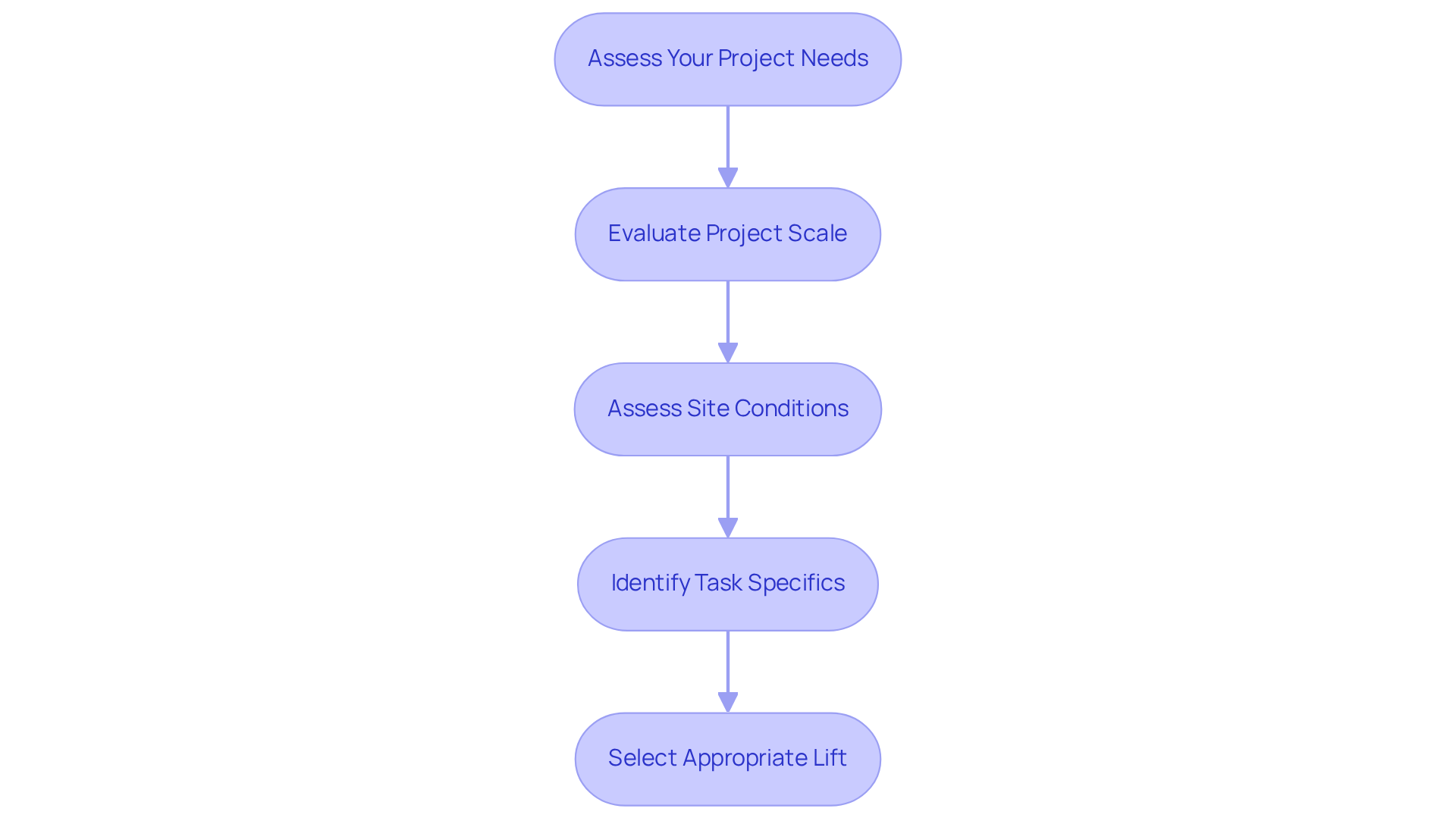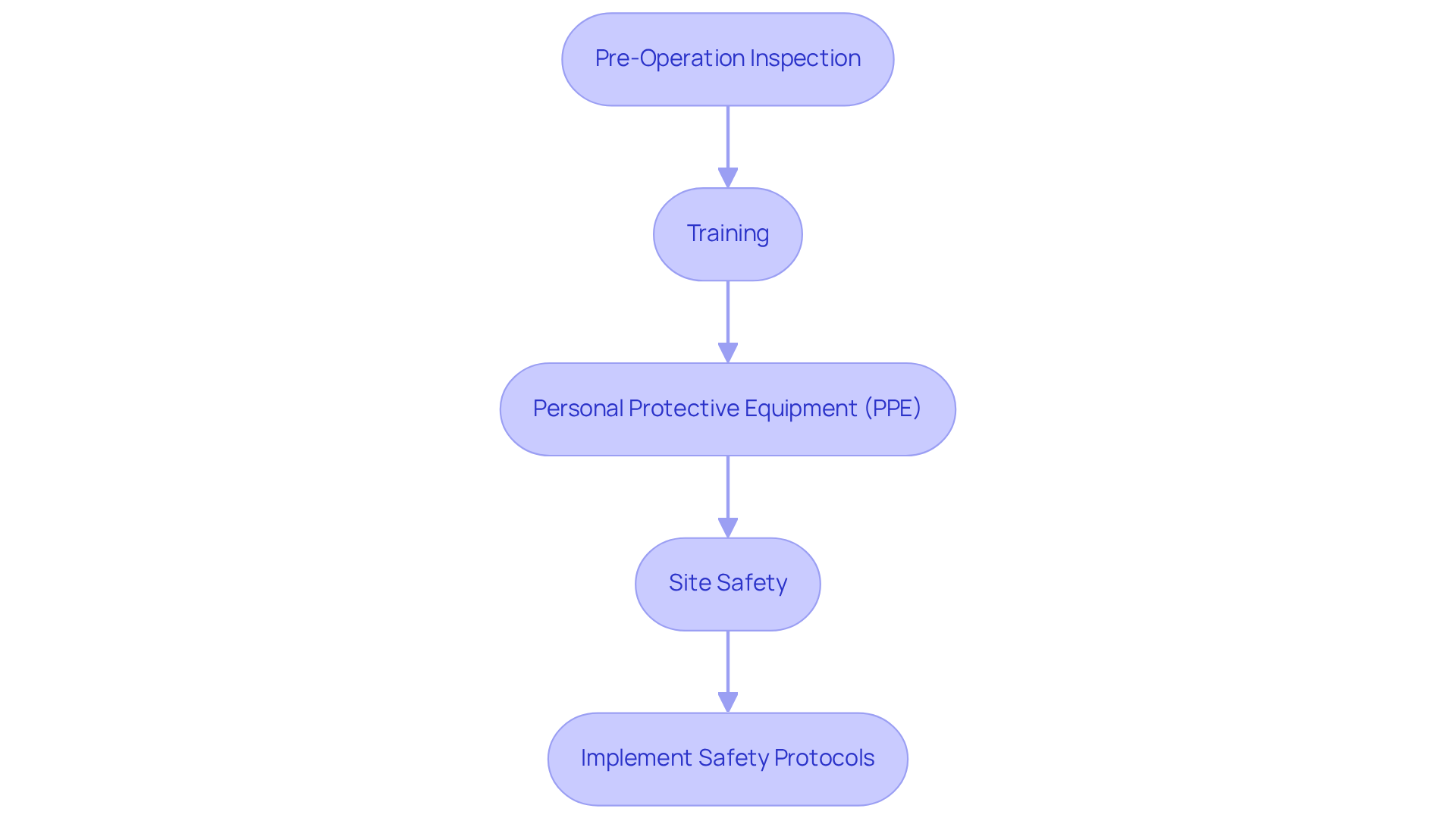Overview
To successfully rent a Skyjack, project managers must first assess their project needs. This initial evaluation is critical in selecting the appropriate model that aligns with specific requirements. Navigating the rental process is the next step, ensuring all aspects are considered, including reviewing agreements and comparing rental options. Furthermore, it is essential to adhere to safety protocols throughout the operation. By following these comprehensive steps, project managers can enhance efficiency and minimize risks, ultimately leading to a successful project execution.
Key Highlights:
- Assess project needs by determining scale, site conditions, and specific tasks to enhance efficiency and ensure timely completion.
- Select the appropriate Skyjack model based on project requirements, considering model types, lift height, capacity, and additional features.
- Research reputable rental companies and request quotes to compare prices and conditions for informed decision-making.
- Thoroughly review rental agreements, focusing on duration, fees, insurance, and maintenance responsibilities to avoid surprises.
- Conduct pre-operation inspections of the Skyjack and ensure operators are properly trained to enhance safety and efficiency.
- Require all personnel to wear appropriate personal protective equipment (PPE) and establish a safe work zone to minimise risks.
Introduction
Navigating the complexities of project management requires making critical decisions about equipment rental, especially concerning aerial lifts like Skyjacks. This guide serves as a comprehensive roadmap for project managers, enabling them to efficiently assess their needs, select the appropriate model, and navigate the rental process with confidence.
With a variety of models and safety protocols to consider, the challenge lies in ensuring that the chosen equipment not only meets project demands but also adheres to stringent safety standards. This article outlines the essential steps for renting a Skyjack, empowering managers to make informed choices that enhance productivity while prioritizing safety on the job site.
Assess Your Project Needs and Requirements
Before leasing a lift, it is crucial to assess the extent of your undertaking to improve efficiency and guarantee prompt completion. Consider the following factors:
- Project Scale: Determine the height and reach required for your tasks. You can rent a skyjack in various models with different lift heights and weight capacities, allowing you to select the most efficient option for your project.
- Site Conditions: Evaluate the terrain and area accessible for maneuvering the lift. Ensure that the ground can support the equipment's weight and that there is enough room for operation, which is essential for maintaining efficiency during tasks.
- Task Specifics: Identify the specific tasks for which you need to rent a skyjack, such as construction, maintenance, or installation work. This will assist in choosing the appropriate design and characteristics, such as the platform size and lift speed, ultimately optimizing your undertaking and improving overall productivity.
By clearly defining these requirements, you can enhance the selection process and ensure that the equipment meets your initiative’s demands. This leads to cost savings and timely completion, making your project a success.

Select the Appropriate Skyjack Model
After evaluating your requirements, it’s essential to choose the right equipment type from EZ Equipment Rental. Begin by considering the following aspects:
- Model Types: EZ Equipment Rental provides a variety of Skyjack models, including both electric and rough terrain options. Electric models are perfect for indoor applications, while rugged terrain types excel in outdoor projects, showcasing their versatility for various construction environments in the DFW Metroplex.
- Lift Height and Capacity: It is crucial to select an option that meets your required lift height and weight capacity. For instance, if your tasks involve reaching high ceilings, choose a model with an elevated lift range. This choice is vital for ensuring safety and efficiency on construction sites.
- Features: Pay attention to additional features that can enhance your operations, such as extendable platforms or advanced control systems. Evaluate how these characteristics can boost productivity and security, particularly when lifting heavy materials and transporting equipment.
By carefully selecting the appropriate equipment from EZ Equipment Rental, you can rent a skyjack that will effectively meet your project's needs while enhancing overall construction efficiency and safety in the DFW Metroplex.

Navigate the Rental Process and Finalize Your Agreement
A systematic approach is required to successfully rent a Skyjack. Start by researching reputable equipment rental companies in your area, such as EZ Equipment Rental, which is recognized for its quality and reliability. This foundational step ensures you are engaging with trustworthy providers who can meet your needs.
Next, request quotes from multiple rental companies. This allows you to compare prices, rental conditions, and the availability of the specific model you require. By gathering this information, you can make an informed decision that aligns with your budget and timeline.
It is crucial to review the rental agreement thoroughly. Pay close attention to terms regarding rental duration, fees, insurance, and maintenance responsibilities. Understanding these details will help avoid any surprises and ensure a smooth rental experience.
Once you are satisfied with the terms, finalize the rental agreement. Ensure you have all necessary documentation ready, including identification and payment information, to facilitate a seamless transaction.
By following these steps, you can navigate the rental process efficiently and confidently rent a Skyjack to secure the equipment you need.

Understand Safety Protocols and Operational Guidelines
Before you rent a skyjack, it is crucial to familiarize yourself with essential safety protocols and operational guidelines to ensure a safe working environment.
-
Pre-Operation Inspection: Conduct a thorough inspection of the Skyjack before you rent a skyjack. Inspect for any apparent damage, ensure that all protective features are functional, and verify that the equipment is in good working order. This step is vital to prevent accidents and ensure reliability during operation.
-
Training: Ensure that all operators are properly trained to rent a skyjack. This training should encompass a comprehensive understanding of controls, emergency procedures, and protective measures. Proper training not only enhances safety but also increases efficiency when you rent a skyjack on the job site.
-
Personal Protective Equipment (PPE): Require all personnel on-site to wear appropriate PPE, such as hard hats, protective eyewear, and harnesses when working at heights. Implementing these safety measures is non-negotiable and serves to protect your team from potential hazards.
-
Site Safety: Establish a safe work zone around where you rent a skyjack. Ensure that the area is clear of obstacles and that bystanders are kept at a safe distance during operation. A well-defined work zone minimizes the risk of accidents and enhances overall safety.
By adhering to these safety protocols, you can help ensure a safe working environment and minimize the risk of accidents. Take action now to implement these guidelines and promote a culture of safety on your job site.

Conclusion
When renting a Skyjack, understanding the process is essential for ensuring project success and safety. This guide underscores the significance of:
- Assessing project needs
- Selecting the appropriate model
- Navigating the rental process
- Adhering to safety protocols
By diligently following these steps, project managers can enhance efficiency and minimize risks on the job site.
Key arguments throughout the article emphasize the necessity of evaluating:
- Project scale
- Site conditions
- Specific task requirements
before making a rental decision. Furthermore, selecting the right Skyjack model—considering factors such as lift height, weight capacity, and additional features—ensures that the equipment meets the demands of the tasks at hand. Thoroughly navigating the rental process, from researching companies to reviewing agreements, lays the groundwork for a smooth rental experience. Lastly, understanding and implementing safety protocols is crucial for protecting personnel and ensuring operational success.
In summary, the process of renting a Skyjack involves careful planning and consideration. By prioritizing project needs, making informed equipment choices, and committing to safety, project managers can significantly enhance productivity and safety on construction sites. Taking the time to follow these guidelines not only leads to successful project outcomes but also fosters a culture of safety and responsibility within the team.
Frequently Asked Questions
Why is it important to assess project needs before leasing a lift?
Assessing project needs is crucial to improve efficiency and guarantee prompt completion by ensuring the selected lift meets the specific requirements of the undertaking.
What factors should be considered when determining project scale?
When determining project scale, consider the height and reach required for tasks, as well as the various lift models available with different heights and weight capacities.
How do site conditions affect lift rental?
Site conditions affect lift rental by determining whether the terrain can support the equipment's weight and if there is enough room for maneuvering, which is essential for maintaining efficiency during tasks.
What specific tasks might require renting a skyjack?
Specific tasks that might require renting a skyjack include construction, maintenance, or installation work, which will help in choosing the appropriate design and characteristics for the lift.
How can clearly defining project requirements lead to cost savings?
Clearly defining project requirements enhances the selection process, ensuring the equipment meets the initiative’s demands, which can lead to cost savings and timely project completion.




